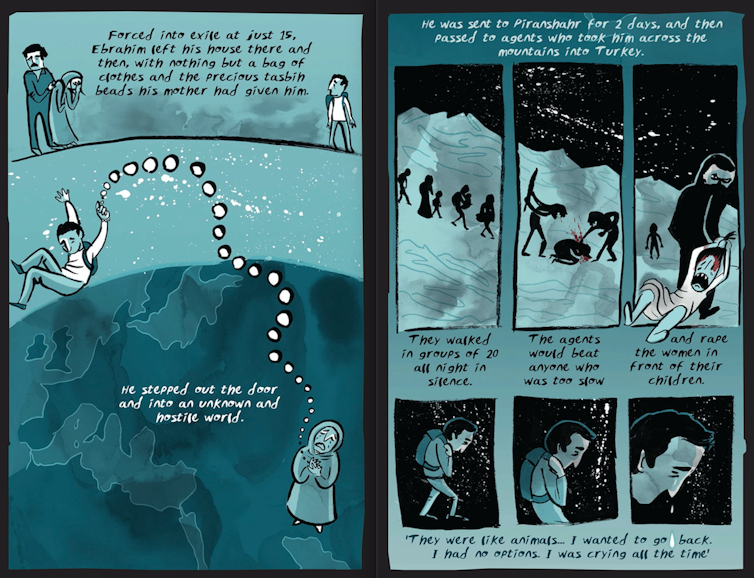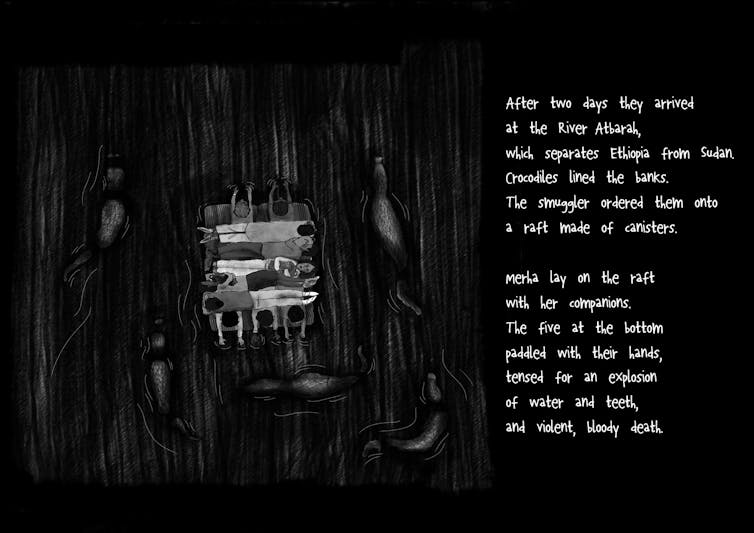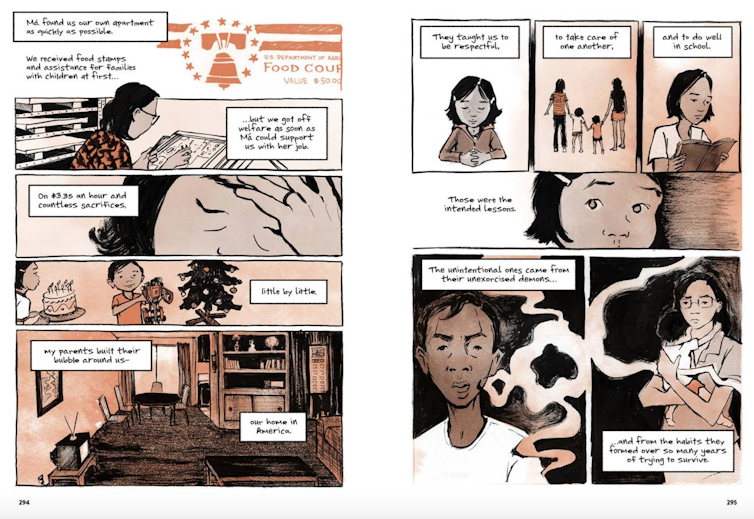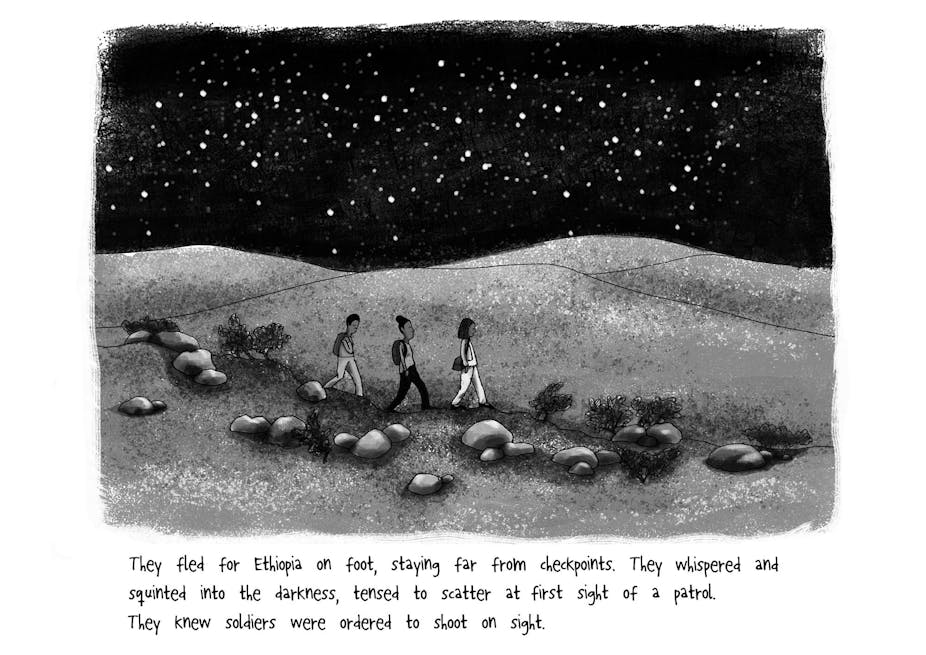When a work of art called the “The List” was installed in July 2018 at the Liverpool Biennial in the UK, it contained the names of 34,361 refugees and migrants who died crossing the borders of Europe since 1996. By September, it had been defaced with the words “invaders not refugees”.
While local officials condemned the culprits as “fascist thugs”, rhetoric which portrays refugees as nameless “invaders” has been used repeatedly by European leaders and politicians in recent years. Such language deliberately dehumanises the estimated 65m people caught up in a global refugee crisis.
Against this backdrop, a recent flurry of comics have begun to tell the individual stories of the refugees and migrants behind these overwhelming statistics. Responding to the near-constant media coverage of border crossings and refugees during 2015 and 2016, they explore personal journeys, experiences of detention and attempts to make new lives in strange lands.
From the New York Times’ Pulitzer-winning Welcome to the New World by Jake Halpern and Michael Sloan, to Threads From the Refugee Crisis by Kate Evans, a growing number of artists and journalists are using graphic stories to share real-life experiences of migration. Reflecting this growing interest in graphic reportage, the House of Illustration in London opened a new exhibition in November, Journeys Drawn: Illustrations from the Refugee Crisis, showcasing 40 original works foregrounding the firsthand experiences of refugees and displaced peoples.
By countering a stereotypical narrative of refugees as faceless invaders, comics can express the stories of the “people who don’t count”, as Evans explains in her book. Comics often visualise scenes unavailable to press photographers. Simple techniques, such as thought bubbles, can be put to complex use, illustrating how a personal story in the present is haunted by traumatic memories from the past. Frame by frame, their sequential images reconstruct difficult experiences and harrowing journeys for readers to witness.
Graphic retellings
A crucial factor in the impact of refugee comics is their accessibility. Digital comics such as Karrie Fransman’s award-winning Over Under Sideways Down, which tells the true story of teenage refugee Ebrahim, demonstrate how versatile graphic narratives can be. Available online for free, the comic depicts Ebrahim’s experiences of fleeing Iran aged 15 and his terrifying odyssey across Turkey and Europe. En route he witnesses shocking violence, including rape, and his identification papers are stolen. Although based on a true account, Ebrahim’s real identity is protected.

Yet Fransman’s drawings bring Ebrahim’s story to life: he leaves Iran with only a precious string of tasbih (prayer) beads, a parting gift from his mother. The simply drawn beads are transformed into an umbilical chord connecting parent and child. Beneath them a global map stretches out, as the dotted beads also record Ebrahim’s route from Iran to the UK. The narrative begins and ends with an image of Ebrahim sat in an armchair, the beads wrapped around his wrist. But the chain of white circles have gained enormous symbolic meaning across the comic’s 20 pages. They are both the markers of his journey and the symbol of everything his new life in Britain has cost him.
Refugee comics are increasingly included in research projects and have been cited by government officials. Fleeing into the Unknown, a short comic produced by the UK-based organisation PositiveNegatives depicts the experiences of Mehra, an Eritrean refugee who left her home to escape forced conscription.

The comic tracks Mehra’s desperate travels across crocodile-infested rivers, sweltering deserts and perilous seas before reaching the UK. Through captions and monochrome images, readers experience every leg of Mehra’s trip, witnessing her growing desperation as she encounters new hardships at every stage.
Fleeing into the Unknown was part of a wider study into decision-making and migration, investigating how and why migrants undertaken such difficult passages into Europe. Other online comics produced by PositiveNegatives were cited during a debate in the British parliament and used to influence public debates on refugee rights.
Arrival isn’t the end
Graphic narratives are also a valuable medium for exploring the long-term effects of being a refugee. In Thi Bui’s best-selling 2017 graphic memoir, The Best We Could Do, Bui chronicles the desperate journey of her parents, while she was still a young child, from war-torn 1970s Vietnam to new lives in America. She explains that: “Though my parents took us far away from the site of their grief … certain shadows stretched far, casting a grey stillness over our childhood.”

Bui illustrates how refugee stories don’t all end with a relieved, safe arrival. Instead, traumatic memories of difficult journeys can resurface decades after their initial experiences. The creeping shadows of ink which spread upon the pages of The Best We Could Do reflect how the trauma of forced migration is transferred across generations. In Bui’s case these memories became a permanent, lingering presence within her family life. Through words and images she describes how her parents lived with “unexorcised demons” and the pain of trying to break “habits they formed over so many years of trying to survive”.
By documenting real journeys, representing traumatic memories and even translating complex research into sequential images, refugee comics have become a powerful tool for illuminating the individual lives overshadowed by a global crisis.

